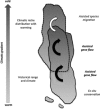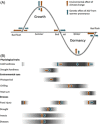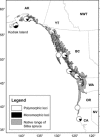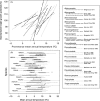Time to get moving: assisted gene flow of forest trees
- PMID: 27087852
- PMCID: PMC4780373
- DOI: 10.1111/eva.12293
Time to get moving: assisted gene flow of forest trees
Abstract
Geographic variation in trees has been investigated since the mid-18th century. Similar patterns of clinal variation have been observed along latitudinal and elevational gradients in common garden experiments for many temperate and boreal species. These studies convinced forest managers that a 'local is best' seed source policy was usually safest for reforestation. In recent decades, experimental design, phenotyping methods, climatic data and statistical analyses have improved greatly and refined but not radically changed knowledge of clines. The maintenance of local adaptation despite high gene flow suggests selection for local adaptation to climate is strong. Concerns over maladaptation resulting from climate change have motivated many new genecological and population genomics studies; however, few jurisdictions have implemented assisted gene flow (AGF), the translocation of pre-adapted individuals to facilitate adaptation of planted forests to climate change. Here, we provide evidence that temperate tree species show clines along climatic gradients sufficiently similar for average patterns or climate models to guide AGF in the absence of species-specific knowledge. Composite provenancing of multiple seed sources can be used to increase diversity and buffer against future climate uncertainty. New knowledge will continue to refine and improve AGF as climates warm further.
Keywords: assisted migration; climate change; ecological genetics; forest policy; genetic clines; local adaptation; provenance; temperate species.
Figures





References
-
- Aitken, S. N. , and Adams W. T. 1996. Genetics of fall and winter cold hardiness of coastal Douglas‐fir in Oregon. Canadian Journal of Forest Research 26:1828–1837.
-
- Aitken, S. N. , and Whitlock M. C. 2013. Assisted gene flow to facilitate local adaptation to climate change. Annual Review of Ecology Evolution and Systematics, 44:367–388.
-
- Aitken, S. N. , and Bemmels J. B. 2015. Data from: Time to get moving: assisted migration of forest trees. doi: 10.5061/dryad.rj15h. - DOI - PMC - PubMed
Publication types
LinkOut - more resources
Full Text Sources
Other Literature Sources

